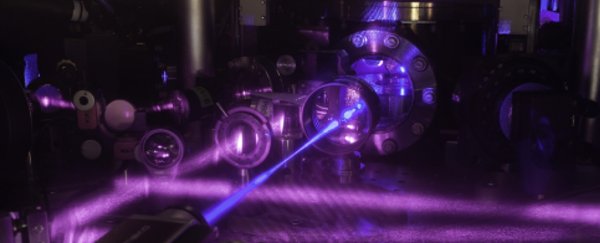A new atomic clock has extended from one dimension to three, becoming the most precise timekeeper in existence - just 3.5 parts error in 10 quintillion (that's 1 followed by 19 zeroes) in two hours.
The clock was built by JILA, a collaboration between the University of Colorado and the National Institute of Standards and Technology, which also built the world's previous record holder for the most precise clock in 2015.
It had a precision of 2 parts error in 1 quintillion (18 zeroes), and could keep time without losing or gaining a second for 15 billion years - longer than the age of the universe.
"We are entering a really exciting time when we can quantum engineer a state of matter for a particular measurement purpose," said NIST physicist Jun Ye.
The 2015 atomic clock was based on a one-dimensional lattice of strontium atoms, held in place by laser beams.
The new clock has expanded this lattice out to a tiny 3D cube, and packed gas at 1,000 times the density of previous, one-dimensional atomic clocks.
Atomic clocks keep time based on the behaviour of the electrons around the atoms of this gas when exposed to radiation. They jump back and forth between two energy states with very fine precision.
The frequency of this electron transition is the basis for atomic clocks' timekeeping.
In one-dimensional atomic clocks, each atom is measured independently, because when they interact with each other, it can cause inaccuracies.
In a cube, though, the gas becomes a globally interacting collection of atoms that move in a pattern to avoid each other, called a "quantum many-body system", minimising collisions and vastly improving accuracy.
The gas makes a difference too. For the first time in an atomic clock, the team used something called Fermi gas, or "quantum gas", a phase of matter that contains a large number of fermions.
Unlike the thermal gases traditionally used in atomic clocks, this Fermi gas allows all the atoms' properties to be restricted for the first time.
These properties mean the clock will be able to be scaled up.
"The most important potential of the 3-D quantum gas clock is the ability to scale up the atom numbers, which will lead to a huge gain in stability," Ye said.
"Also, we could reach the ideal condition of running the clock with its full coherence time, which refers to how long a series of ticks can remain stable. The ability to scale up both the atom number and coherence time will make this new-generation clock qualitatively different from the previous generation."
And it can reach the same precision as previous atomic clocks 20 times faster, maintaining stable ticks for 10 seconds with 10,000 strontium atoms packed in at a density greater than 10 trillion atoms per cubic centimetre.
"This represents a significant improvement over any previous demonstrations," Ye said.
Accurate timekeeping isn't just important for making sure you get to the doctor on time. It's vital to science. An incredibly precise atomic clock is able to help with both timekeeping and navigation for research purposes.
It can also help define and refine time measurements. "One mississippi" works for hide-and-seek, but the accuracy provided by atomic clocks has codified the standard second.
And atomic clocks are a fascinating tool in the search for dark matter.
When atomic clocks interact with dark matter, they can speed up or slow down - but by absolutely miniscule fractions of a second. Synchronised atomic clocks can make these discrepancies detectable in a way that other clocks cannot.
"This new strontium clock using a quantum gas is an early and astounding success in the practical application of the 'new quantum revolution,' sometimes called 'quantum 2.0'," said Thomas O'Brian, Ye's supervisor.
"This approach holds enormous promise for NIST and JILA to harness quantum correlations for a broad range of measurements and new technologies, far beyond timing."
The team's research has been published in the journal Science.
